Example cases
The Parkinson Smartwatch system is designed to support you and the patient with Parkinsons disease, especially when response-fluctuations (wearing off, 'on-off', delayed on, peak dose dyskinesia, diphasic dyskinesia, non-motor symptoms, etc) occur.
Its main function is an electronic diary system, to allow a patient to show you which hours are 'off' ( stiff, slow, tremor, etc., indicating too low l-dopa levels), good or dyskinetic (which are most often peak dose related).

Movement status is simply recorded by the patient with a single tap on the watch and supported by accelerometry. The system uses colors: green is ok, yellow is off, red represents dyskinesia. The continuum at the watch is transformed to seven intervals for presentation in charts.

Patients also record an event when they eat, take pills or go to sleep. Simply by tapping on an icon at the front of the watch.
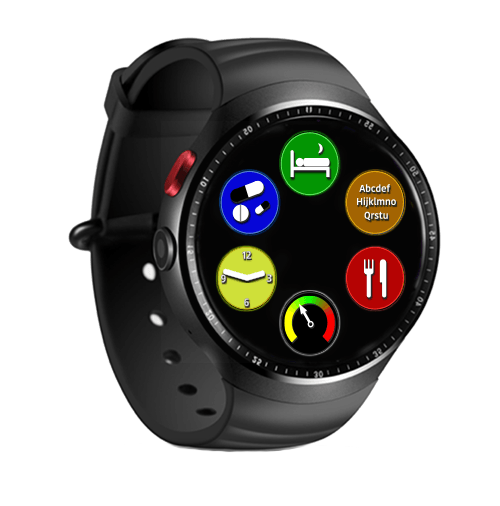
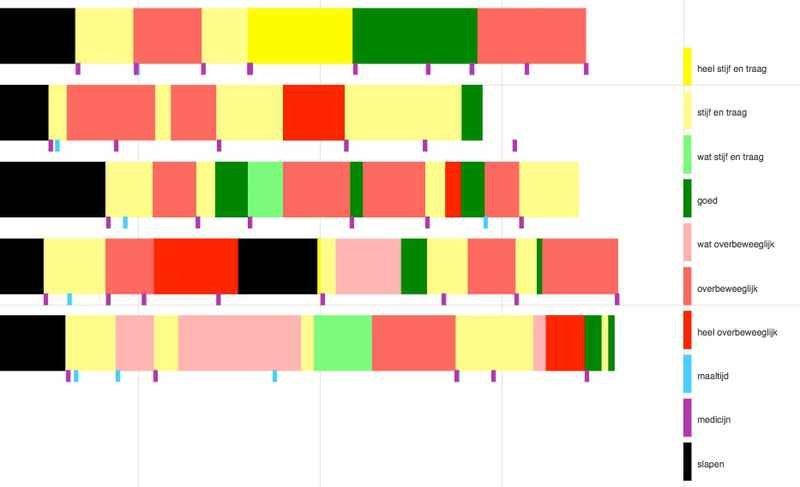
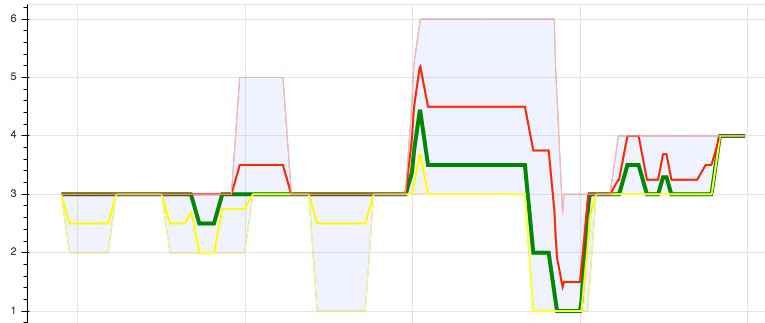
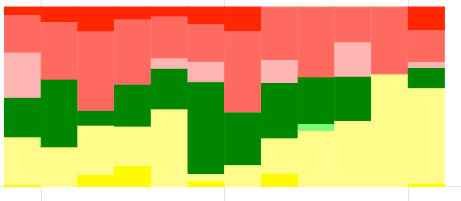
With this detailed record of the course of response fluctuations, you gain insight in the pharmacokinetic profile of a patient, which allows you to tailor the medication schedule. We present several examples and treatment strategies at this site.
Parkinson smartwatch also provides the patient with a personalized system to improve compliance: a smart medication reminder system shows a picture of the pills at the required time on the watch.
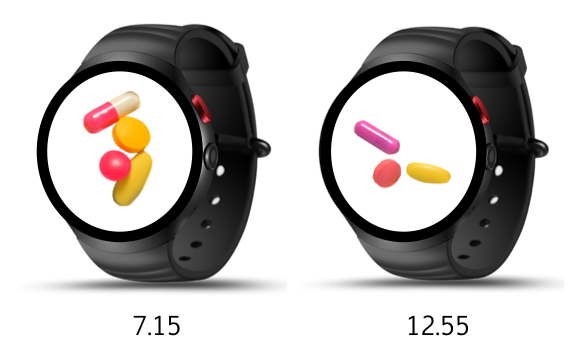
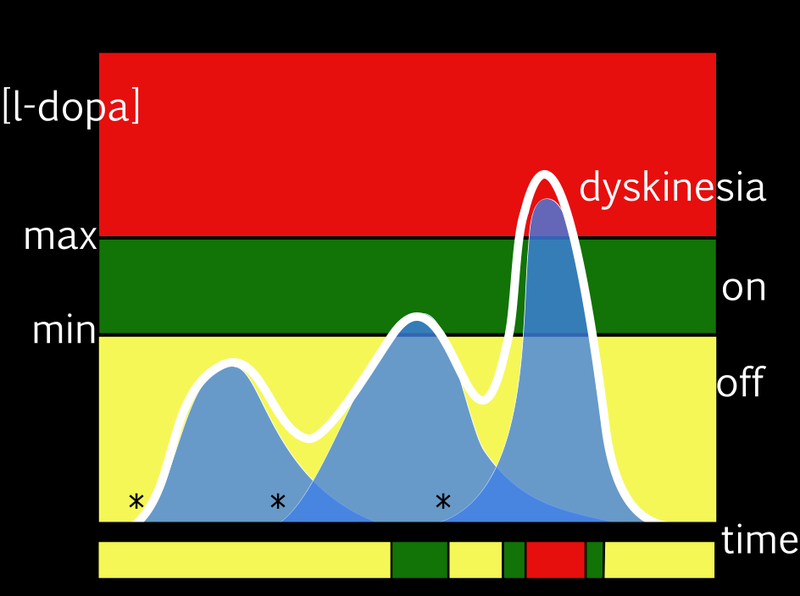
L-dopa levels above the line between the green and the red zone, occur where patients are overtreated. They usually experience motor symptoms like dyskinesia (i.e. involuntary choreodystonic movements) or non-motor symptoms ( e.g. mania or hypersexuality).
Parkinson’s is a degenerative disease. The disease worsens over time. Therefore, medication needs to be adjusted from time to time.
This requires a tailored medication scheme.
Choosing an effective treatment strategy, benefits a lot from the ability to reconstruct a presumed model of the pharmacokinetic profile of levodopa. As shown in the example above, an approximation of the white line (the levodopa availability) can be reconstructed from the course of the fluctuating symptoms (the diary, shown at the bottom bar), and the intake times ( the 3 *).
In this case, the first of three doses is too low. It could be adjusted by increasing the first dose, or adding a soluble levodopa dose at the same time. Reduction of the third dose may reduce the occurrence of dyskinesia.
This example of 'delayed on' may also represent low intestinal levodopa uptake of the first gift, due to intake of pills together with a meal. To detect this simple but frequent cause of undertreatment, PSW therefore records both intake times, and meal times.
A 62-years-old patient has had PD for 3 years, treated with levodopa/carbidopa, three times a day.
He tells you he is quite satisfied, he functions quite well, and is fine with the current treatment schedule.
Last week he started recording his PD status using Parkinson smartwatch.
From the website he read instructions and watched the video. He tells you what he did:
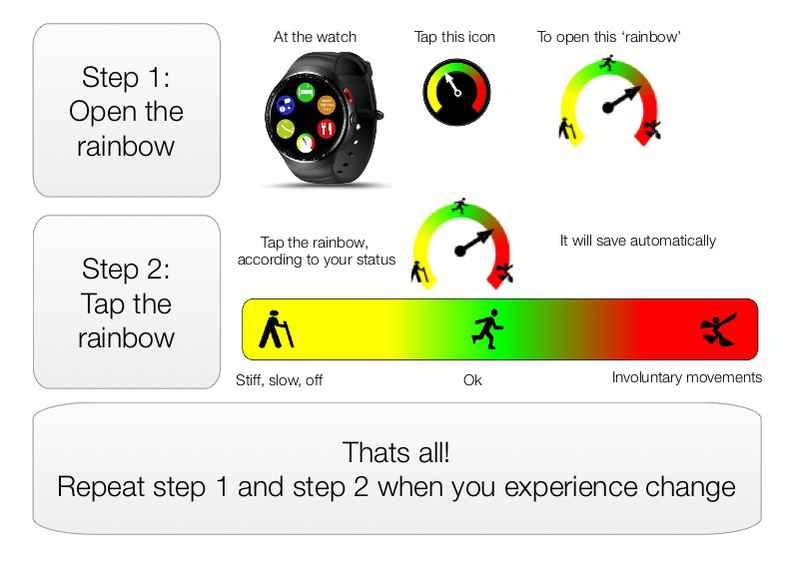
He only used the left yellow half of the ‘rainbow’ to record his motor status, because he never had dyskinesia. He also recorded meals, sleep and pill intake using these icons



with a single tap at the watch.
He asks you to connect to his portal, where data can be viewed. You find his data in your personal list of your patients that use Parkinson smartwatch.
In his portal a chart shows the average score of the last 30 days:

You recognize a consistent off period at 7 p.m. The patient confirms this: around this time he stays at home, knowing things get worse, he can hardly do anything useful then. Both of you agree to change the treatment schedule to try to improve. You start by changing the prescribed time for his last pill of the day to an hour earlier.
Three weeks later you watch his chart again: the off period vanished. The patient is happy to confirm this during a short telephone call. He will stop recording his status now, but will resume it in the month before the next appointment, to provide you with an impression of his status then.
A 54-years-old patient with PD tells you his life is a mess. He experiences PD as an enemy who always wins. You ask him to record a few days using Parkinson smartwatch.
This is the resulting chart:

Looking at the on-off scores, you conclude it resembles how he describes his life. His total schedule is very unorganised. The purple little blocks indicate when pills were taken. This also appears to happen at random, whenever felt needed, or guided by ‘gut feeling’. He cannot explain exactly how he does it. But looking at the chart he agrees with you that this is not a likely way to get a consistent response.
Together you decide to change the treatment strategy, to one with more consistency. You prepare him, telling that this will not be an instant succes. Monitoring his status with the charts, enables you to adapt the treatment schedule gradually.
He will start using the Parknson smartwatch medication reminder, with a regular schedule of levodopa/carbidopa 4 times a day,
